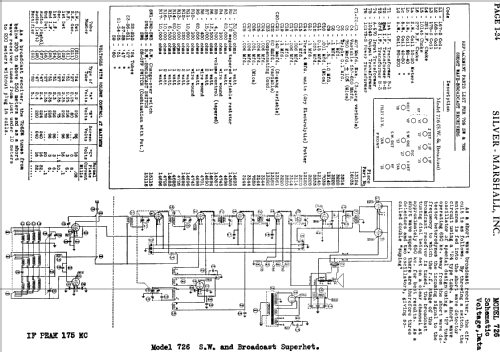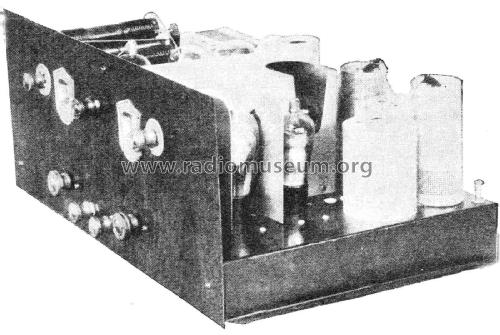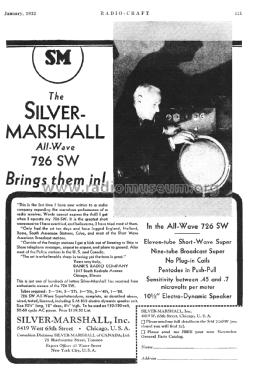All-Wave 726SW (early version)
Silver - Marshall; Chicago, IL
- Pays
- Etats-Unis
- Fabricant / Marque
- Silver - Marshall; Chicago, IL
- Année
- 1931
- Catégorie
- Radio - ou tuner d'après la guerre 1939-45
- Radiomuseum.org ID
- 57942
Cliquez sur la vignette du schéma pour le demander en tant que document gratuit.
- No. de tubes
- 11
- Principe général
- Super hétérodyne, conversion double ou triple; FI/IF 175 kHz; Tube à grille écran 1926-1935.
- Circuits accordés
- 11 Circuits MA (AM)
- Gammes d'ondes
- PO et plus que 2 x OC
- Tension / type courant
- Alimentation Courant Alternatif (CA) / 110-120 Volt
- Haut-parleur
- HP dynamique à électro-aimant (électrodynamique) / Ø 10.5 inch = 26.7 cm
- Matière
- Boitier métallique, lampes visibles
- De Radiomuseum.org
- Modèle: All-Wave 726SW - Silver - Marshall; Chicago, IL
- Forme
- Chassis (pour intégration dans meuble)
- Dimensions (LHP)
- 20.5 x 8.5 x 12 inch / 521 x 216 x 305 mm
- Remarques
- If this model 726SW hat for the start the tube 35 or 235 then it can only be from May 1931 or later. One dial (primary tuning control knob); push-pull output stage. Probably only for the new version: As a short wave broadcast receiver, the antenna is fed into the short wave detector circuit using a 24 type tube. A short wave oscillator of special design using a '27 tube, operating at 650 kc away from the short wave detector heterodynes the incoming signal to the frequency to which the RF stage of the broadcast receiver is tuned, the broadcast tuning dial being set on a clear channel at approx. 650 kc for best results. As a short wave super, there are therefore three detectors and two oscillators, giving so called double "suping".
- Source extérieure
- Ernst Erb
- Source du schéma
- Rider's Perpetual, Volume 1 = 1931/1934 (for 1919-1931)
- D'autres Modèles
-
Vous pourrez trouver sous ce lien 225 modèles d'appareils, 116 avec des images et 122 avec des schémas.
Tous les appareils de Silver - Marshall; Chicago, IL



